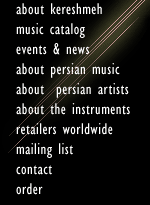


TANBUR
The tanbur is the ancestor to most long-necked, plucked stringed instruments. Its pear shaped belly is normally carved out of one piece of mullberry wood with a long neck and fourteen gut frets. Some modern tanburs are made of bent ribs of mulberry wood. The sound board, 3-4 millimeters thick, is also made of mulberry wood which has numerous small holes for better resonance.
The tanbur has a unique playing technique by which the strings are strummed with the fingers of the right hand to produce a very full and even tremolo called shorr (literally meaning the pouring of water). This technique along with various kinds of plucking, usually with the index and pinky fingers, enables the musicians to produce different effects and various rhythmic accentuations which imitate the natural sounds of their environment such as a running stream, a water fall, a bird chirping or a horses' gallop, all translated into musical rhythms and sounds.
The ancient tanbur used to have two silk or in some instances gut strings tuned in 4th or 5th, similar to the dotar (meaning two stringed), its close relative widely used in Eastern Iran. It has also been regarded as the tanbur of Khorasan in literary texts. Although these two instruments share a similar history and are basically the same, they have developed their own repertoires, playing techniques and functions. According to the master instrument maker Ustad Mehdi Kamalian the name tanbur is taken from the word tandur or tanur, meaning clay oven, as early instrument makers dried tree trunks chosen to carve the belly in tanours for several hours in order to perfect the sound. Gradually the instrument took on the name tanbur.
The present tanbur has three strings and covers the range of one octave and two notes. The lower pair of strings, made of steel, are tuned in unison normally anywhere from a (flat) to b and are fingered together functioning as the melody strings. The top string made of copper or brass, slightly thicker, tuned in lower fourth or fifth, functions as a sympathetic string with occasional fingering by the thumb.
The tanbur has always been considered a sacred instrument associated with the Kurdish Sufi music of Western Iran and it is believed that its repertoire is based on ancient Persian music. Up until the last fifty years this instrument was used only during djamm gatherings (devotional or liturgic ceremonies) of the Ahle-Haqq (the people of truth), followers of a particular Sufi order.
Text by Kayhan Kalhor, Spring 1997